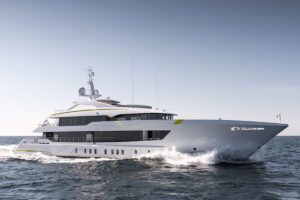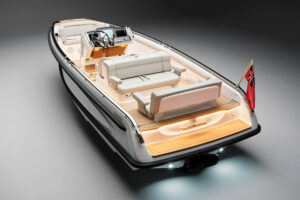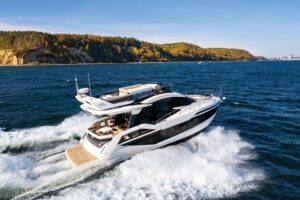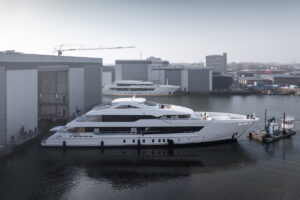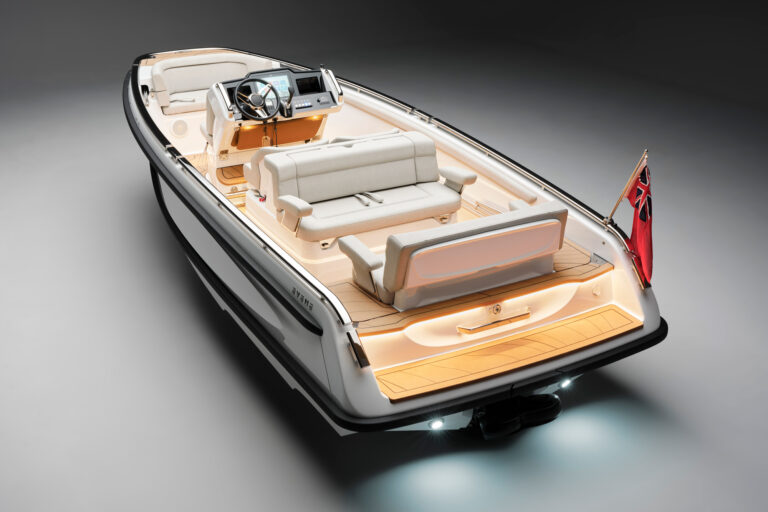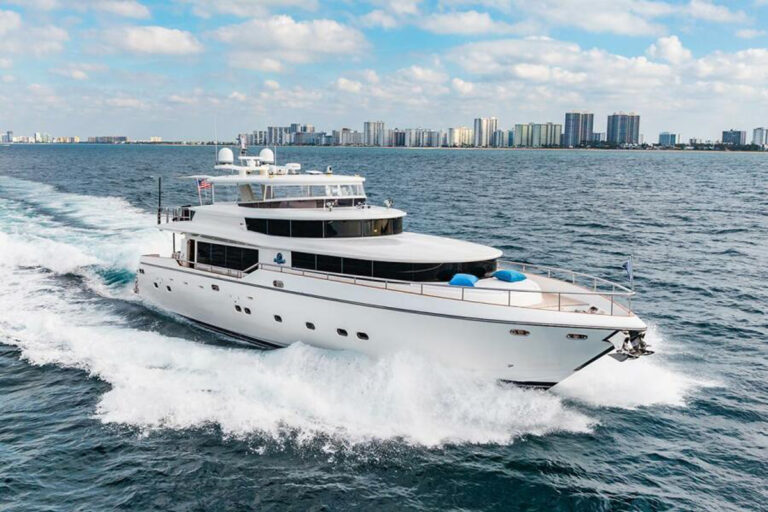Just inside North Carolina’s Core Banks, within sight of the Cape Lookout lighthouse, grand homes and little cottages in varying states of disrepair once lined the waterfront. With an influx of new residents and new money, the more significant buildings have been restored, and new homes and condos have displaced the lesser structures. Gone with them are most of the local boatbuilders who designed and built commercial fishing boats for themselves and, later, delivered “Carolina flare” sportfishing boats to out-of-towners.
Jarrett Bay Boatworks, along nearby Adams Creek, has preserved and built on that tradition for the past 15 years. It recently delivered its largest sportfisherman yet, the 68-foot Adaro. Custom designed for owners Jay and Karen Johnson, Adaro is cold-molded wood, triple diagonal planked with fir in the bottom and ocume on the sides. In addition to the expected bow flare, she has a sweet sheer curve that wraps into a considerable bit of tumblehome at the stern.
Her business end is a teak-soled cockpit designed for serious fishing. It stretches 14 feet from side to side and yields 12 1/2 feet of clear length from the transom bait well to the 30-inch-deep tackle lockers and reefers, the doors of which have hands-free, foot-pedal openers. A Release Marine chair swings on an offset mount to allow easy access to the large, in-deck fishbox. The bait well, 6 feet wide, has a removable center divider and two independent pump systems. The transom door swings out, and the covering board is solid above the door, both features that help the stern resist significant structural loads when backing down hard.
Along the house side, stout rails above the curved window line offer a solid handhold, but in the tradition of these custom Carolina boats, there are no side rails here or on the foredeck. Instead, the periphery of the deck is given a coat of nonslip finish, and the varnished teak toerail is raised at the sheer. One can debate the safety of such an arrangement-many argue that, regardless of railings, you shouldn’t be on the foredeck while under way-but it sure keeps the appearance sleek and uncluttered.
The flying bridge is open, but during our test trip, curtains forward and to the side kept all but the worst spray away from the two seats at the helm. Companion seating forward of the helm, complete with too-rare cup holders, stayed dry and free of wind. These benches, 6 1/2 feet to port and 7 feet to starboard, were each long enough to accommodate a quick nap. When things get nasty and fishing becomes a secondary concern, additional curtains can provide a full enclosure.
The house top extends about 30 inches abaft the helm seats, allowing passage behind them to tend the six rodholders, and offers some protection for those sitting on the cockpit lockers below. The overhang is not so long that it interferes with the captain’s sight lines during a hookup, however.
With topsides of flawless gleaming white, only Adaro’s varnished transom gives a clue to her rugged wood construction, which is wrapped inside and out with 3412 tridirectional fiberglass on the bottom, and lighter 1808 and 2408 bidirectional, exterior only, on the sides. Stringers are solid wood and, in the engineroom, capped with aluminum channels.
Adaro‘s hull has a moderate vee forward with fairly flat sections aft. That makes her faster in anything up to a healthy chop, but on the 6-footers we encountered offshore, the hull took an occasional punch that was more uncomfortable for the guests than for the boat. Adaro has four stringers aft, two of which extend the full length of the boat. Transverse floors are spaced at about 4-foot intervals, with additional egg crating built into the forward sections. Extra thickness is built into the hull aft to carry the concentrated loads imposed by rudders and propeller shaft struts.
The Johnsons moved up to Adaro from a smaller boat, also custom built, and did not consider a production boat in their search for a larger fishing platform. Both had definite ideas for their new boat. Inside Adaro, the input of both is evident, but it is obviously Karen’s domain. Joinery is quartersawn figured American cherry, and graceful arches in the cabinet doors echo that of the saloon’s after window. Countertops are mica-flecked black granite. The cabin’s sole is cherry with ebony inlays, and sisal with a tweed pattern is used for many of the bulkheads.
The galley is a clever arrangement of two U-shapes, separated by the passage to the accommodation stairway. All cooking needs are concentrated in the port half. Here, appliance garages take advantage of oddly shaped spaces in the sloping house front, and clear Lexan fronts on upper drawers and cabinets make it easier for guests, as well as the petite Karen, to see what’s in them.
Beverage and other casual service is handled in the starboard half of the galley. As Karen explained, this allows guests to get drinks and be a part of the action without interfering with the cook.
Similar thought went into the accommodation layout. The master stateroom is forward, but the berth is not a high, cramped island shoved into the bow. Instead, the master head is here, and the berth is farther aft, diagonal to the port side, for a bit more space and comfort at sea.
Guests occupy a twin-berth cabin with head to port, and crew are in a starboard-side cabin with upper-and-lower berths. When I remarked on the crew head, which is also the day head, being the largest on the yacht, Karen was quick with a sensible reply. Not only does the crew need the space, as they spend the most time aboard, but it is easier to keep the head tidy for day use since it is crew, not guests, maintaining it.
“That way,” Karen said, “I don’t have to keep after my guests to remove their toiletries each morning.”
All cabins have hanging lockers, and additional stowage is built in below the sole, accessible via hatches in the cabin soles.
The 68-foot Adaro, which the Johnsons plan to keep in Key Largo (central to their plans for fishing the Keys, Mexico and the Bahamas) is only temporarily the largest Jarrett Bay sportfisherman. A 74-footer is under construction for delivery this summer.
That doesn’t mean the yard is abandoning its smaller models. You can still order a 25-foot outboard and as a custom builder, Jarrett Bay will deliver anything in between.
Contact: Jarrett Bay Boatworks, (252) 728-2690; www.jarrettbay.com_._

